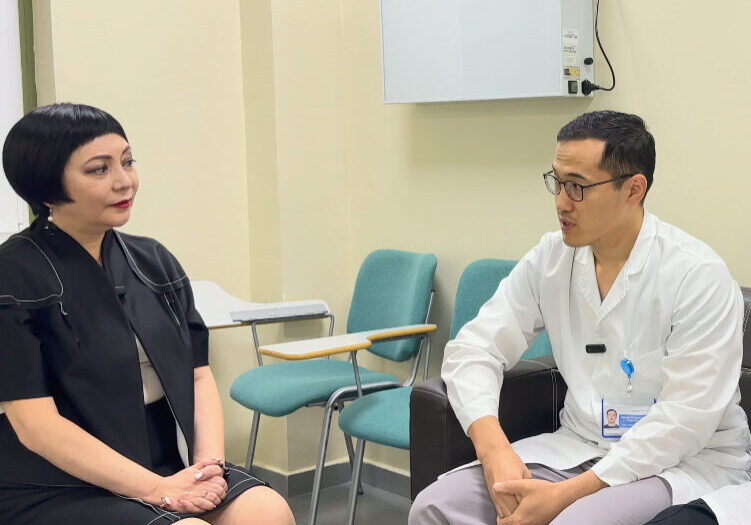
Parkinson’s Disease Treatment in Kazakhstan
Содержание
Sholpan Esmukhambetova, head of the Medsolution Clinic office in Astana, met with a group of functional neurosurgery doctors. Our doctors specialize in treating Parkinson’s disease.
Parkinson’s disease is a progressive neurological disease that affects the motor system.
Parkinson’s disease symptoms may include:
Shaking of the hands, feet, jaw
Difficulties with balance and coordination
The slowness of movement (bradykinesia)
Muscle stiffness and stiffness
Changes in speech and handwriting
What are the most effective treatments for this disease? What surgeries are performed for Parkinson’s disease in Kazakhstan?
Read about all the nuances in examining patients, and choosing treatments and equipment for treating Parkinson’s disease on the Medical Solution Tour blog.
How are patients being examined for Parkinson’s disease?
Sholpan Esmukhambetova: Hello! We meet with a functional neurosurgery group and we talk about a very serious disease – Parkinson’s disease. Patients who find out that they have such a complicated diagnosis start asking questions: where can I get help? How effective can this help be? How does a patient get to a Parkinson’s disease care center? We’re talking to a team that deals with patients with Parkinson’s disease. Let’s talk about what issues a patient might be concerned about and what kind of care you provide.
Seitzhan Aidarov: Hello, my name is Seitzhan Aidarov, I am a neurologist in the functional neurosurgery group. When a patient comes to our clinic for Parkinson’s disease for the first time, he comes to me first. I perform history taking, complaint gathering, and initial examination of the patient. I also do a neurological examination. If necessary the patient is referred for additional examinations. After gathering information, we can already make adjustments to the patient’s treatment (if necessary). If the patient is a candidate for surgery, we invite him or her to surgical treatment. What are the indications for surgery? For Parkinson’s disease, these indications are stage 2 – 4, positive reaction to levodopa drugs, presence of side effects of drug therapy, such as motor fluctuations (fluctuating effects of levodopa), drug dyskinesia (involuntary, violent movements in different muscle groups) and patient’s age up to 70 years old.
Absolute contraindications to taking levodopa drugs are also an indication for surgery. Gross organic brain damage according to MRI examination is a contraindication to surgical intervention. The operation must not be performed in the presence of severe cognitive impairment, presence of severe depression, presence of severe somatic diseases, presence of coagulopathy, and presence of psychotic disorders.
Our doctor Chingiz Nurimanov, head of the functional neurosurgery group, and our second neurosurgeon Nurtai Nurakai will explain more about further actions during the treatment of the patient.
How surgery for Parkinson’s disease goes
Nurtai Nurakai: After contact and examination by a neurologist, all indications for treatment are determined for the patient. Next, the patient is screened for surgical treatment. Not all patients with Parkinson’s disease need surgery. If surgery is still needed, the patient is admitted to our department. Within two to three days he is ready for surgery.
The surgical treatment itself is performed in several stages.
- The patient wakes up in the morning and undergoes an MRI scan.
- Before the MRI, a special stereotactic frame is installed. It is fixed on the head. The examination is performed in this frame. Our task is to determine the targets and coordinates of the targets, depending on the type of movement disorder.
- After the MRI study, planning is done at the station. This is done with a special program. It determines the coordinates, the targets, the targets, the structure of the brain. The coordinates are then determined by stereotactic frame.
First stage of surgery is performed under local anesthesia. The patient must be conscious. During the surgery, his neuro status is assessed, and his symptoms and complaints that are most disturbing today are evaluated. For example, the patient may complain of tremors – it is evaluated how it regresses. Depending on this, stimulation of targets and targets is performed.
What treatment for Parkinson’s disease can be considered successful?
Sholpan Esmukhambetova: How many patients with Parkinson’s disease have passed through your department? How many such stories have you had in your practice?
Nurtai Nurakai: We have been carrying out this type of surgical treatment since 2013. Our clinic has already treated about 300 patients with surgery. Almost all patients received positive treatment results. The main goal of this type of treatment is to improve quality. Facilitate daily living and physical activity of the patient. Reduce the doses of medications taken and bring the patient as close to normal life as possible.
How long does it take to have surgery for Parkinson’s disease?
Sholpan Esmukhambetova: If we’re talking about a foreign patient, is 10 days enough time for treatment? During this time will he be able to get the whole complex of services?
Or do they need more time?
Nurtai Nurakai: We have our own nuances in terms of time. It is better to find out when considering each individual case. The stage of the surgical treatment itself takes 10 days. Then the patient has to be checked after a certain period of time.
What equipment is used in the treatment of Parkinson’s diseas
Sholpan Esmukhambetova: Could you tell us please, what equipment you work with? What kind of equipment is used? How is it high-tech and does it comply with international protocols and regulations?
Chingiz Nurimanov: This type of surgery is performed on the most modern equipment. We have two stereoscopic frames, and both are the most modern and high-tech. We also have very modern diagnostic equipment – two MRI machines, one and a half and three words MRI. There is also a CT machine that shows 128 slices. The accuracy of the electrodes we place is very high, the error is less than one millimeter. All surgeries are performed under the close supervision of neuroanimatologists, neurologists, and neurosurgeons. The department of our clinic is specialized for this group of patients and for this operation.